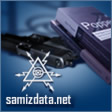We are developing the social individualist meta-context for the future. From the very serious to the extremely frivolous... lets see what is on the mind of the Samizdata people.
Samizdata, derived from Samizdat /n. - a system of clandestine publication of banned literature in the USSR [Russ.,= self-publishing house]
|
Life is always better when I have a book on the go which I can hardly wait to get back to. The Blind Watchmaker by Richard Dawkins is not quite going to be that for me. Too complicated. Not central enough to the things I happen now to be interested in, probably because I already agree with it far too completely for it to grab me by the throat. But, I have recently been dipping into this book, having finally got hold of a cheap second-hand copy of it, and yesterday I came across an argument in it which I found familiar, but in another context.
Dawkins criticises Bishop Hugh Montefiore (on page 38 of my 1991 Penguin paperback edition) for again and again resorting to the argument that he just cannot believe that this or that complex organ or organism could possibly have evolved. → Continue reading: Arguments from incredulity
Excellent, a new skycar prototype will be travelling from London to Timbuctoo, via ground and air. There is a nostalgic coolness about skycars as they reflect a legacy future where 1940s starlets are rescued by a world of modern skyscrapers and heroes in jetpacks. In reality, the car will be driven by the SAS and the Foreign Office provides its doleful advice that adventures are ‘dangerous’. Couldn’t they go to Cleethorpes instead and why can’t we force them to, thinks the man from the FO?
As well as natural barriers, the team has been warned about the threat of kidnap in volatile parts of Africa and the car will have to negotiate a minefield in Mauretania – “I might fly that one,” said 45-year-old expedition leader Neil Laughton.
When the need for flight arises – estimated to be for 40% of the journey – a ParaWing, a parachute of the type used by paragliders, will be dragged behind the modified off-road buggy and the propeller on the back of the vehicle will boost the Skycar down whatever happens to be serving as an improvised runway. When it reaches 45mph, enough lift should be generated to get the car airborne, its weight supported only by “a silk handkerchief, a large one at that”, said Laughton.
The adventure is referred to as an element of “mad Brits“, another phrase redolent of passing qualities. More details on the car can be found here, though one must accept that not all prototypes will be stylish Italian jobs. This one looks more like a souped up Dune buggy.
Following on from my post earlier about what sort of things might be regarded as wrong or intolerable by future generations that are widely done now, this book by David Friedman (son of Milton F), which looks at potential future legal, scientific and ethical controversies, looks interesting. For instance, Friedman asks what might happen to inheritance wrangles where the “deceased” is in fact held in cryonic suspension and hence not technically dead, as might be defined in a specific legal code. Some of this stuff might appear pure science fiction, but SF has a way of sometimes becoming reality. After all, the very fact that many people can afford to not use animal products such as leather has been made possible by synthetic fibres and materials such as plastic, something that did not exist about 100 years ago. Other developments could also make certain moral controversies either irrelevant or shift the boundaries markedly, or raise controversies that no-one has to contend with now.
On the dystopian side, the developments going on in IT might raise such worries about how the state might try to do things like implant computer chips into people’s bodies as a sort of ID system. Only the innocent have anything to fear…
Yesterday was the fifth anniversary of the arrival on Mars of the Mars Exploration Rover Spirit. Despite a few problems to do with their age, both this rover and its identical twin Opportunity are in good working order and are still wandering around the surface of Mars and sending back interesting findings.
The obvious first thing to do is to congratulate everyone who had anything to do with these missions for a truly magnificent achievement. During my life, watching NASA’s manned space program has been intensely frustrating. Huge amounts of money have been spent on overly expensive boondogles that achieve less than was achieved in the years around the time I was born, despite there being no shortage of new and exciting things that could be achieved. At the same time, though, and on vastly smaller budgets, the unmanned probes produced by and with NASA/JPL to explore the planets and the solar system have managed magnificent achievement after magnificent achievement. Since I was a child we have learned so much about the planets and the solar system, and I have found it hugely inspiring. Seeing high resolution photographs of the moons of Saturn, or the surface of Mars, or the Great Dark Spot of Neptune – who would have imagined such things.
And yet, one thing that amazes me even more is the strange way in which NASA planetary probes stretch and warp time. For instance, the two Mars rovers were sent to Mars on missions that were supposed to last for 90 days. Both missions are now at five years, which is a little over 20 times the original length of the mission. This is an extreme example, but these missions often dramatically outlast their stated lifetimes. A four year Mars Global Surveyor mission turns into nine years. The Cassini mission to Saturn has been there for the planned four years, has had its funding extended for another two, and may manage more than that.
One reason why missions are able to be extended for long periods is of course the extraordinary ingenuity of the people who run them. That software is being upgraded and hardware used in unplanned ways to fix all manner of problems with stuck robotic arms, failed high-gain antennas, wheels getting a little sticky, rovers stuck in sand-dunes, and that these things so often seem to work is another thing that amazes me.
Yet, I wonder further. Clearly, when these missions are launched the hope is that they will keep going a lot longer than stated in the “mission objectives”. Clearly, also, in many cases the principal scientific goals will be achieved in the first few days or months after arriving at the destination, so what decides success is what happens shortly after arrival. Arguing that “everything else is a bonus” after the core objectives are achieved is probably fair.
How much of it is politics, though? I am sure it is easier to get funding for a five year old mission on the basis that “We have a rover on Mars that is still working and it would be a horrible shame to end the mission now” than asking for six years of funding at the beginning. I am sure also that when scientists are told that “You can’t have funding for A, B, C, and D, but we will give you funding for A and B”, they will find a way to include C and D while pretending that A and B is all they are doing, particularly if A and B are Jupiter and Saturn, and C and D are Uranus and Neptune.
And yet, when a 90 day mission is still going after five years, I cannot help but think that someone, somewhere, is taking the piss out of someone. All I can ask is that they please keep doing it.
Scientists are planning to ignite a tiny Man-made star, according to this Daily Telegraph article. I wonder if the scientists or the journalists writing on their activities have seen the film, Sunshine, about which reviews have been mixed?
Wired magazine has a neat item about ten species of creature that were discovered in 2008. Alas, as the comments in the article suggest, some people remain far more interested in the species varieties that have gone extinct this year. What perhaps needs to be stated is that in a constantly changing world, species are evolving and others are dying out, even without the allegedly malign influence of Man. What the deep Greens often do not seem ready to concede is that species have been wiped out before without the help of us naughty bipeds.
I have just heard on an infrastructure mail list that India has lost much international bandwidth and the problem is due to failure on the SeaMeaWea3, SeaMeaWea4 and FALCON submarine cable systems at Alexandria.
There were multiple failures in Alexandria just a few months ago if I remember correctly.
Less than an hour ago I cited Dr. Arthur Kantrowitz’s work on Science Courts in a Samizdata discussion, and in one of those strange and in this case saddening cases of synchronicity, I have just received an email notification that he passed away on November 29 at the age of 95.
Dr. Kantrowitz was a true gentleman of Science and will be much missed by all who have ever crossed his path.
I am sure others will have much more to say about his long career in the hard sciences.
A hat tip to Counting Cats for the report. Jeff Foust has the story here.
I have been waiting for this news, as have many others, for months. Peer review of the test results have shown no reason why the technology will not work, although Dr. Nebel is quick to point out that nothing in the results guarantees it either.
Now… onwards to the next set of tests!
Reason TV has a very fine lecture by Bjorn Lomberg on global warming available. Bjorn is one of the few people out there who represent a position similar to mine. Yes, it is happening; yes, there will be winners and losers… but it is not the end of the world.
He shows in case after case how governments are throwing away billions upon billions of dollars, pounds, and yen for ‘solutions’ which will have virtually no effect at all.
It is well worth watching.
I suppose it is a sign of advancing years, and having lost some close friends to cancer or having been scared by a close relative’s condition that the notion of a cure for the gremlin should weigh on my mind a bit more than it used to. (You are definitely getting old, Ed). I cannot help noticing, when reading Instapundit as I do every day that Glenn Reynolds has been putting up regular links to the growing use of nanotechnology in delivering cancer-busting chemicals to the body with incredible accuracy. Here’s another one. The more accurate the delivery of the drug, so the reasoning goes, the fewer the unpleasant side-effects associated with things like chemo treatments, and the greater chances of beating the cancer. The steady trickle of news items and articles has yet to become a flood, but I have this sense that the flood may be pretty close.
When I read Engines of Creation by Eric Drexler back whenever it was, the idea of tiny nanobots being used to treat cancer was, then, still on the edge of what folk thought might be possible. There is a way to go yet but it is a mark of how certain stories get below the radar of current events that nano-medicine has crept up on us so quickly, rather as the internet did about 20-odd years ago.
Faster please!
In an electronics market in China last month, I found these intriguing items for sale.
Okay, “MP3” I understand. The MPEG-1 standard for digital media storage and transmission contained three audio formats. These were MPEG-1 audio layers 1, 2 and 3. Of these, layer 3 provided the highest audio quality, became the standard for compressed digital audio, and “MPEG-1 layer 3” became abbreviated to “MP3”.
“MP4” is slightly more problematic. The successor standard to MPEG-1 was MPEG-2. MPEG-2 is very important, but mainly because it contains much more advanced video formats than MPEG-1. DVDs and most digital television applications use MPEG-2 video. In terms of audio, MPEG-2 contains the three existing formats from MPEG-1 (including MP3) and a more advanced format called Advanced Audio Coding (AAC). Perhaps confusingly, AAC is very seldom used with MPEG-2 video, which is much more frequently paired with the MPEG-1 audio formats, or with Dolby AC-3 (which is not part of any of the MPEG standards).
However, AAC is also part of the MPEG-4 family of standards. (There is no MPEG-3). Due partly to AAC being the favourite audio standard of Apple, AAC is commonly paired with the video standards of MPEG-4, the two most common of which are the Advanced Simple Profile (MPEG-4 part 2) and the now favoured Advanced Video Coding (MPEG-4 part 10, known also as ITU-T H.264). This partnering between AAC and the MPEG-4 family of standards can mean that AAC audio is sometimes referred to as “MP4 audio”, with “MP4” as an abbreviation of “MPEG-4”, even though AAC as a format technically preceded MPEG-4. In addition, media of this form is often encoded using the MPEG-4 part 14 container format, which usually has the file suffix “.mp4”. Thus it makes a certain amount of sense for an AAC or MPEG-4 capable media player to be referred to as an “MP4 player”. In this case the “4” in MP4 means something different to the “3” in MP3, but there is some logic to it.
As to what an MP5 player might be, that is on a par with the European commission announcing that we must take steps to “put Europe into the lead of the transition to Web 3.0”, I fear. Sadly, I think it is unlikely that they are selling these.
|
Who Are We? The Samizdata people are a bunch of sinister and heavily armed globalist illuminati who seek to infect the entire world with the values of personal liberty and several property. Amongst our many crimes is a sense of humour and the intermittent use of British spelling.
We are also a varied group made up of social individualists, classical liberals, whigs, libertarians, extropians, futurists, ‘Porcupines’, Karl Popper fetishists, recovering neo-conservatives, crazed Ayn Rand worshipers, over-caffeinated Virginia Postrel devotees, witty Frédéric Bastiat wannabes, cypherpunks, minarchists, kritarchists and wild-eyed anarcho-capitalists from Britain, North America, Australia and Europe.
|





